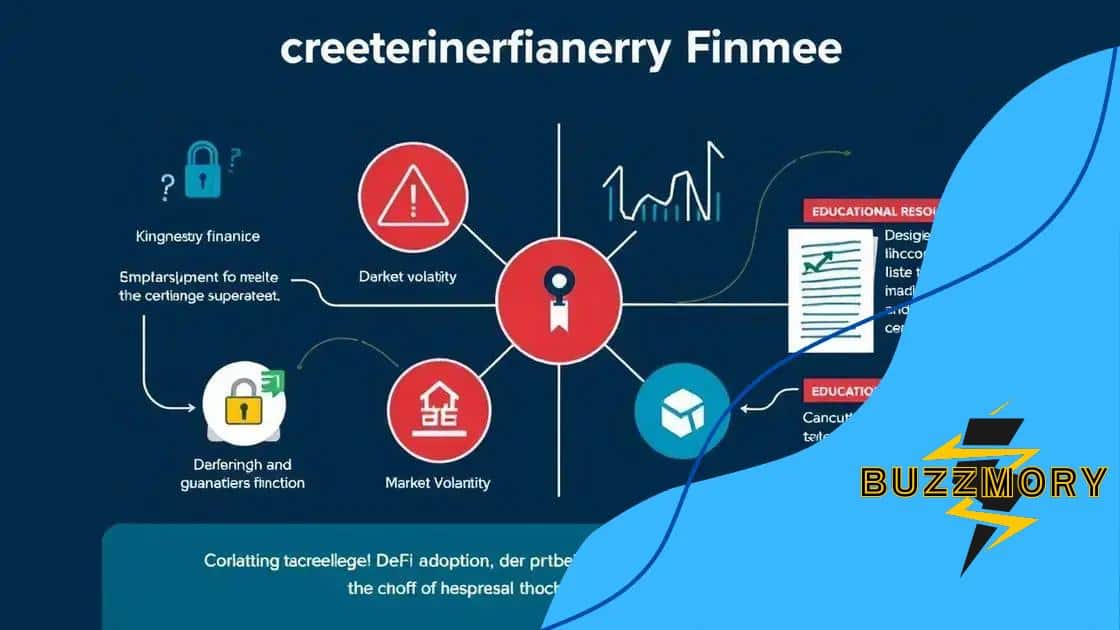How decentralized finance (DeFi) is disrupting traditional banking

Decentralized finance (DeFi) disrupts traditional banking by offering peer-to-peer financial services, lower costs, and enhanced accessibility, requiring banks to adapt and integrate innovative solutions to stay relevant.
How decentralized finance (DeFi) is disrupting traditional banking is a topic stirring conversations among financial experts and everyday users alike. As DeFi continues to evolve, questions arise about its potentials and pitfalls. Have you ever wondered how these changes might affect your banking experience?
Understanding decentralized finance (DeFi)
Understanding decentralized finance (DeFi) is essential as it defines a new era in the financial landscape. DeFi leverages blockchain technology to provide open financial services without intermediaries.
DeFi operates on platforms that allow users to lend, borrow, trade, and earn interest on their assets. This approach promotes transparency and accessibility, challenging traditional banking norms.
Key Concepts Behind DeFi
Several foundational concepts underpin the DeFi ecosystem:
- Smart Contracts: These self-executing contracts automate transactions when predetermined conditions are met, ensuring trust without the need for intermediaries.
- Decentralized Applications (dApps): Applications running on blockchain networks, offering various financial functionalities securely and transparently.
- Liquidity Pools: Users can provide funds to these pools to facilitate trading and earn fees, promoting liquidity within the ecosystem.
As we delve deeper into how DeFi compares to traditional banking, it’s clear that the model fosters greater financial inclusion. For instance, anyone with internet access can participate, breaking down geographical and economic barriers.
Benefits of Decentralized Finance
DeFi offers numerous advantages:
- Transparency: All transactions are recorded on the blockchain, making them traceable and open for scrutiny.
- Lower Fees: By eliminating intermediaries, users often enjoy reduced transaction costs and increased profits.
- Greater Control: Individuals maintain control of their assets, reducing reliance on traditional financial institutions.
The implications of DeFi are vast, prompting traditional banks to rethink their service models and adapt or risk obsolescence. As users become more informed about these decentralized options, the pressure mounts on legacy banking systems to evolve.
Key features of DeFi compared to traditional banking
Key features of DeFi compared to traditional banking highlight how decentralized finance transforms financial services. While traditional banks operate under strict regulations and centralized control, DeFi offers a more open and flexible approach.
One of the main features is the absence of intermediaries in DeFi. Users can directly interact with financial services through blockchain technology, enabling peer-to-peer transactions. This not only speeds up the process but also reduces costs. It’s fascinating how DeFi returns power and control to the users.
Transparency and Security
In DeFi, transparency is a core principle. All transactions are recorded on a public ledger, making them traceable. This level of open access contrasts sharply with the typical banking system, where information is often kept behind closed doors. Security remains paramount in DeFi because of cryptographic protocols that safeguard users’ assets.
- Open Source: Most DeFi protocols are open-source, allowing developers to review, audit, and improve systems collaboratively.
- Global Access: DeFi services can be accessed from anywhere in the world, breaking down geographical barriers.
- Lower Fees: Without intermediaries, users benefit from significantly reduced transaction fees.
Moreover, the accessibility of DeFi services opens doors to millions who previously didn’t have access to traditional banking. DeFi platforms allow users to earn interest on their assets, lend, or borrow funds without the need for intricate documentation often required by banks. This process not only enhances user engagement but also fosters financial literacy among the masses.
Flexibility in Financial Products
The range of products offered in DeFi is vast and constantly evolving. Users can easily switch between services, such as lending or trading, on various platforms. This flexibility promotes innovation and competition. Additionally, anyone can create a financial product without the long application processes typical in traditional finance.
As DeFi continues to gain traction, traditional banks face pressure to innovate and adapt their services. They must consider user demands for transparency and cost-effectiveness. Understanding these key features emphasizes how DeFi not only complements but challenges the established banking model.
Risks and challenges of DeFi adoption

Risks and challenges of DeFi adoption play a crucial role in understanding the landscape of decentralized finance. As DeFi continues to grow, users must be aware of potential obstacles and risks that accompany this innovative financial frontier.
One of the primary challenges is security. Although blockchain technology is generally secure, incidents of hacking and fraud have occurred. When users interact with DeFi platforms, they often expose themselves to vulnerabilities. It’s vital for users to conduct thorough research on protocols and to ensure their assets are stored safely.
Smart Contract Risks
Another significant risk lies in smart contracts, which are the backbone of DeFi applications. These contracts execute automatically based on defined conditions. However, flaws in the code can lead to exploitations.
- Code Exploits: If a smart contract contains vulnerabilities, malicious actors can manipulate it to steal funds.
- Upgrade Issues: Making changes to a smart contract can be complicated, leaving old vulnerabilities unpatched.
- Audit Limitations: While many projects undergo audits, not all are scrutinized to the same extent, leading to potential gaps in security.
Beyond security concerns, regulatory uncertainty presents another challenge. Governments across the globe are still grappling with how to regulate DeFi. This ambiguity can create risks for users, as future regulations might impact the operation of these platforms and the legality of certain services.
Market Volatility and User Awareness
Additionally, DeFi markets can be highly volatile. Changes in cryptocurrency prices can affect the value of assets in an instant. Users must be prepared for market fluctuations and have strategies in place.
Finally, user awareness is crucial. Many participants may lack the necessary knowledge to navigate the DeFi space safely. Education and resources are essential to help users understand risks and make informed decisions. Engaging with communities and utilizing trustworthy platforms can significantly reduce exposure to risks.
Real-world examples of DeFi in action
Real-world examples of DeFi in action showcase how decentralized finance is transforming financial services today. Numerous projects demonstrate the potential of DeFi to disrupt traditional banking by offering innovative solutions.
One prominent example is Uniswap, a decentralized exchange (DEX) that allows users to trade cryptocurrencies directly without intermediaries. Users can provide liquidity by depositing their tokens into liquidity pools, earning fees from trades. This model exemplifies how DeFi creates opportunities for earning while facilitating seamless transactions.
Yield Farming and Lending Protocols
Another fascinating case is Aave, a lending platform where users can lend and borrow cryptocurrencies without the need for a centralized authority. Through this platform, users can earn interest on their deposits while others can take out loans by providing collateral. This process exemplifies how DeFi enhances the accessibility of financial services.
- Compound: Similar to Aave, Compound allows users to earn interest by lending their tokens and borrow against their cryptocurrency holdings.
- Yearn Finance: This platform automates yield farming strategies to maximize returns for users, simplifying the process and making it more accessible.
- MakerDAO: A stablecoin system that allows users to generate Dai by locking collateral in smart contracts, proving the ability of DeFi to provide stable value in a volatile market.
These examples illustrate not only the functionality of DeFi but also its potential to offer inclusive financial solutions. Users across the globe can participate regardless of their location or economic status, which broadens access to essential financial services.
Moreover, platforms like SushiSwap and Curve Finance highlight the community-driven aspect of DeFi. By allowing users to contribute to the development and governance of the platforms, these examples showcase how users can have a say in shaping the future of finance.
The future of banking in a DeFi world
The future of banking in a DeFi world presents a vision where traditional banks may become obsolete or transform significantly. As decentralized finance (DeFi) continues to gain traction, it challenges the very foundation of conventional banking systems.
In this evolving landscape, banks might need to adapt and integrate DeFi features to stay relevant. For instance, embracing blockchain technology could streamline operations and enhance security. By utilizing smart contracts, banks could automate processes, reducing manual errors and increasing efficiency.
Integration of Traditional and Decentralized Finance
We might see a hybrid model emerge where traditional banks collaborate with DeFi platforms. This integration could offer customers the best of both worlds, combining the reliability of established institutions with the innovative, user-friendly nature of decentralized solutions.
- Custodial Services: Banks can provide custodial services for cryptocurrency assets, ensuring their safety and accessibility for users.
- Compliance and Regulation: Traditional banks may help navigate the complex regulatory landscape, ensuring DeFi applications remain compliant.
- Enhanced Offerings: By incorporating DeFi, banks can enhance their product offerings, providing clients with greater flexibility and new financial instruments.
Furthermore, the user experience in banking could drastically improve. With the rise of DeFi, customers are already accustomed to low fees and greater control over their finances. Banks will need to enhance their digital offerings, providing intuitive platforms that meet these new expectations.
Challenges and Adaptations
However, transitioning to this new model is not without challenges. Traditional financial institutions must grapple with adapting to new technologies while ensuring customer trust and security. The decentralized nature of DeFi might pose regulatory hurdles that banks need to address carefully.
The impact on employment within banks is also a consideration. As automation through DeFi and blockchain grows, roles may shift. Staff may need to focus more on digital literacy and risk management rather than traditional banking tasks.
As we envision the future, it’s clear that banking will evolve significantly. The successful banks of tomorrow will likely embrace innovation, combining their trusted services with the advantages of DeFi to create a more inclusive and efficient financial ecosystem.
FAQ – Frequently Asked Questions about DeFi and the Future of Banking
What is decentralized finance (DeFi)?
Decentralized finance (DeFi) refers to financial services that use blockchain technology to operate without intermediaries, allowing for peer-to-peer transactions.
How does DeFi challenge traditional banking?
DeFi provides more accessibility and lower costs, allowing users to manage their finances without reliance on traditional banks, thus shifting the financial landscape.
What risks should users be aware of when using DeFi?
Users should be aware of security risks, smart contract vulnerabilities, and the potential for regulatory challenges in the rapidly changing DeFi environment.
Will banks integrate DeFi features in the future?
Yes, banks may need to integrate DeFi features to stay relevant, offering innovative services while collaborating with decentralized platforms.





